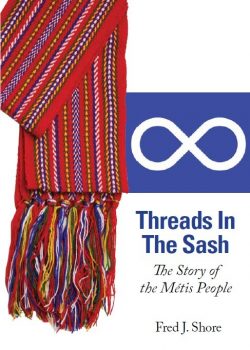
Examining the founders of Manitoba
New book by professor and alumnus Fred Shore illuminates the history of the Métis
Indigenous Awareness Month began with a three-part speaker series on the Métis – the first from University of Manitoba alumnus and Native Studies professor Fred Shore.
As a pre-launch to his new book, Threads in the Sash: The Story of the Metis People, Shore read an excerpt from it, answering why the people once denounced as ‘half-breeds’ are now recognized as key players in Manitoba’s history.
Who are the Métis? As Shore explains, through exploration of the history, culture and political development of the Métis, there isn’t a single definitive answer.
 Shore is a leading Métis historian and scholar. He earned his Master’s degree in history from the U of M in 1983 and completed his PhD in 1991 with his thesis, The Canadians and the Métis: The Re-Creation of Manitoba, 1858-1872. His experiences and research areas are vast but he primarily focuses on Métis history and political issues of Indigenous people throughout Canada. Working since 1985, Shore is the second longest serving faculty member in the Department of Native Studies at the U of M.
Shore is a leading Métis historian and scholar. He earned his Master’s degree in history from the U of M in 1983 and completed his PhD in 1991 with his thesis, The Canadians and the Métis: The Re-Creation of Manitoba, 1858-1872. His experiences and research areas are vast but he primarily focuses on Métis history and political issues of Indigenous people throughout Canada. Working since 1985, Shore is the second longest serving faculty member in the Department of Native Studies at the U of M.
Drawing upon Shore’s expertise and teachings on the Métis, Threads in the Sash digs deep into history to explore and illustrate many aspects of Métis culture that have mystified nearly everyone. Pemmican Publications, the publisher of the book describes it as “a valuable and enlightening history of the Métis, from their beginnings in Canada’s emerging fur trade through the creation of Manitoba and the rise of a proud and distinct people.”
Shore says that despite the many differing opinions on who the Métis are, there is a way to move forward.
“Canada and Canadians will have to defer to the Métis as they are the ones who know who they are,” says Shore.
Laura Forsythe, a Métis Master’s student in the Department of Native Studies and the Métis Inclusion Coordinator at the Indigenous Student Centre, sees Threads in the Sash as a vital contribution to Métis history.
“This book answers the question of who are the Métis as a people outside of politics and the race discussion. It will be a useful tool for both Métis and allies in and outside of the academy to understand the origins of my people,” says Forsythe.
Through Threads in the Sash, Shore outlines three prevailing thoughts on the origins of the Métis people.
First, that the Métis came from the French fur trade depots. These were small outposts, often in the middle of nowhere that needed to be watched. Two voyageurs would be assigned to watch each of them, who would then often find two willing First Nation women who would join them, for company and possibly a little romance. The isolated community resulted in cultural compromises which created the Métis culture and the Michif language.
Another common belief is that Métis are defined as the offspring of European/Caucasian and Indigenous men and women. This belief doesn’t account for the cultural relevance of Métis history carved by the Red River Settlement.
Finally, others believe that Métis people also stemmed from non-status First Nations – who were pushed to the outskirts of both Indigenous and non-Indigenous communities. As Shore explains, this group of First Nations people became outcasts, not accepted by either their home communities or by settlers. They found a home with the Métis.
At the talk on Mar. 5, Shore said the book was a long time in the making, which at first started out as an academic output to define Métis people and culture. That changed though, resulting in an enchanting and witty read that could truly be enjoyed by anyone.
“I wanted to overcome the paucity of information on the Métis that would be read by the average person,” says Shore.
With the creation of a Manitoba provincial holiday in Louis Riel’s name, the Métis have come to national prominence. Threads in the Sash shines a light on an aspect of Canadian history that has been kept in the dark. The publication examines why the people who were once denounced as ‘half-breeds’ are now recognized as Indigenous people, while at the same time acknowledging the fact that this culture, and these people helped build what is now the province of Manitoba.
“By writing and publishing this book in a non-academic way that would be available to all, I wanted to define and explain with short text, who the Métis are,” says Shore.







